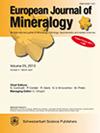H2O degassing triggered by alkali depletion in bimodal magma injection processes – a new experimental approach
IF 1.7
3区 地球科学
Q2 MINERALOGY
引用次数: 0
Abstract
Abstract. The injection of mafic magma into a hydrous felsic magma chamber is a potential trigger mechanism for bimodal explosive volcanism. As H2O is the most abundant volatile component in magmas, the interaction and the degassing behavior of mildly peralkaline hydrous rhyolitic melt in contact with hydrous basaltic melt were investigated by decompression experiments. Preparatory hydration experiments and bimodal magma decompression experiments, as well as reference experiments, were carried out in an internally heated argon pressure vessel. Pre-hydrated rhyolite and basalt cylinders were perfectly contacted together in a precious-metal capsule, heated to 1348 K at 210 MPa, and thermally equilibrated for 10 min. The initial sample properties were determined by a bimodal reference experiment, quenched immediately after equilibration. To simulate the magma ascent, three bimodal samples and a decompression experiment with two contacted rhyolite cylinders for testing the experimental setup were decompressed with 0.17 or 1.7 MPa s−1 to the final pressure of 100 MPa and then quenched. All decompression experiments resulted in vesiculated samples. The H2O vesicles observed in the decompressed sample of the monomodal rhyolite–rhyolite reference experiment are homogeneously distributed throughout the sample. The former interface between the contacted glass cylinders is invisible after decompression and quench. This reference experiment proves that the two-cylinder design does not influence the degassing behavior of the hydrous melt, e.g., an increased formation of vesicles at possible nucleation sites at the contact plane of the cylinders. The undecompressed bimodal rhyolite–basalt sample shows crystal-free rhyolitic glass, whereas 3 µm sized idiomorphic magnetite crystals coexist with glass in the basaltic part of the sample. Within the 10 min run time, a ∼ 300 µm wide hybrid composition zone developed between the hydrous rhyolitic and basaltic endmembers, caused by diffusion-induced mixing processes. Decompression and quenching of the bimodal melts resulted in vesiculated glass samples. A ∼ 100 µm wide zone of alkali-depleted rhyolitic glass as part of the ∼ 300–560 µm wide hybrid zone is covered with an enhanced number of H2O vesicles compared to the pristine rhyolitic and basaltic glass volumes. We suggest that this enhanced vesiculated zone forms by a rapid diffusional loss of alkalis from the mildly peralkaline rhyolitic melt into the basaltic melt of the sample. The reduced alkali concentration significantly reduces the H2O solubility of the rhyolitic melt. This process enhances the H2O supersaturation necessary for vesicle formation during decompression. In summary, the new findings imply that convective magma ascent driven by the injection of hot basaltic magma into a hydrous peralkaline rhyolitic melt reservoir leads to enhanced H2O vesicle formation near the melt interface and thus to efficient degassing. This in turn can accelerate buoyancy-driven magma ascent and mingling and mixing processes that induce further degassing and potentially trigger explosive volcanic eruptions.双峰岩浆注入过程中碱耗尽引发的水脱气——一种新的实验方法
摘要镁铁质岩浆注入含水长英质岩浆室是双峰爆发火山活动的潜在触发机制。由于H2O是岩浆中最丰富的挥发性成分,通过减压实验研究了轻度过碱性含水流纹岩熔体与含水玄武岩熔体的相互作用和脱气行为。在内部加热的氩气压力容器中进行了预备水合实验、双峰岩浆减压实验以及参考实验。预先水合的流纹岩和玄武岩圆柱体在加热至1348的贵金属胶囊中完美地接触在一起 K在210 MPa,并热平衡10 min。通过双峰参考实验测定初始样品性质,在平衡后立即淬火。为了模拟岩浆上升,用0.17或1.7对三个双峰样品和两个接触的流纹岩圆柱体进行减压实验,以测试实验装置 兆帕 s−1至最终压力100 MPa,然后淬火。所有减压实验都产生了气泡状样品。在单体硅镁石-流纹岩参考实验的减压样品中观察到的H2Ovesicles在整个样品中均匀分布。在减压和淬火之后,接触的玻璃圆柱体之间的前一界面是不可见的。该参考实验证明,双圆柱体设计不会影响含水熔体的析气行为,例如,在圆柱体接触面上可能的成核位置增加气泡的形成。未压缩的双峰流纹岩-玄武岩样品显示无晶体的流纹岩玻璃,而3 µm大小的自形磁铁矿晶体与样品玄武岩部分的玻璃共存。在10 最小运行时间,a~ 300 由扩散诱导的混合过程引起的含水流纹岩和玄武岩端部之间形成了µm宽的混合成分区。双峰熔体的减压和淬火产生了气泡状玻璃样品。A~ 100 µm宽的贫碱透晶石玻璃区域,作为 300–560 与原始的流纹岩和玄武岩玻璃体积相比,µm宽的混合带覆盖着数量增加的H2O气泡。我们认为,这种增强的气泡区是由轻度过碱性流纹岩熔体中的钾快速扩散损失到样品的玄武岩熔体中形成的。降低的碱浓度显著降低了流纹质熔体的H2O溶解度。这个过程增强了在减压过程中形成囊泡所必需的H2O过饱和度。总之,新的发现表明,由热玄武岩岩浆注入含水过碱性流纹岩熔体储层驱动的对流岩浆上升导致熔体界面附近H2O囊泡的形成增强,从而实现有效的脱气。这反过来又会加速浮力驱动的岩浆上升以及混合和混合过程,从而引发进一步的脱气,并可能引发火山爆发。
本文章由计算机程序翻译,如有差异,请以英文原文为准。
求助全文
约1分钟内获得全文
求助全文
来源期刊
CiteScore
2.80
自引率
9.50%
发文量
40
审稿时长
6-12 weeks
期刊介绍:
EJM was founded to reach a large audience on an international scale and also for achieving closer cooperation of European countries in the publication of scientific results. The founding societies have set themselves the task of publishing a journal of the highest standard open to all scientists performing mineralogical research in the widest sense of the term, all over the world. Contributions will therefore be published primarily in English.
EJM publishes original papers, review articles and letters dealing with the mineralogical sciences s.l., primarily mineralogy, petrology, geochemistry, crystallography and ore deposits, but also biomineralogy, environmental, applied and technical mineralogy. Nevertheless, papers in any related field, including cultural heritage, will be considered.

 求助内容:
求助内容: 应助结果提醒方式:
应助结果提醒方式:


